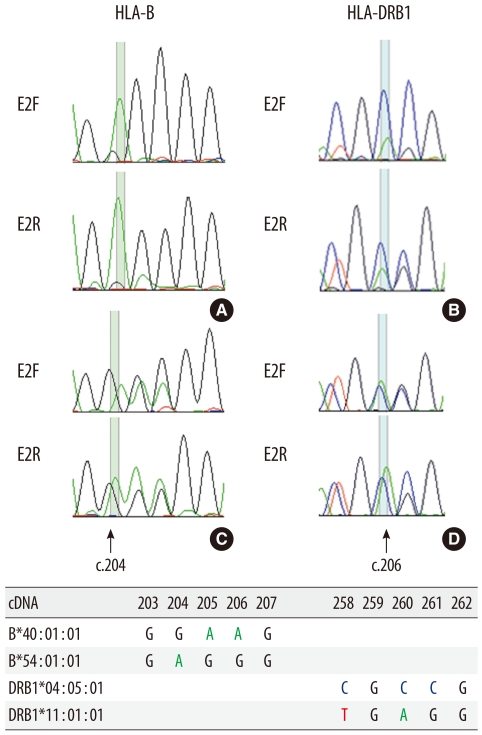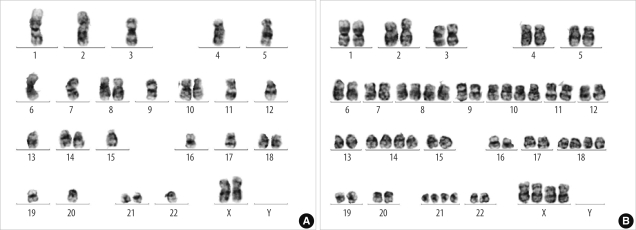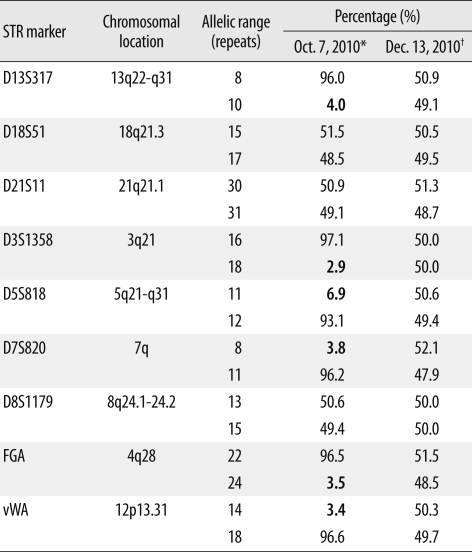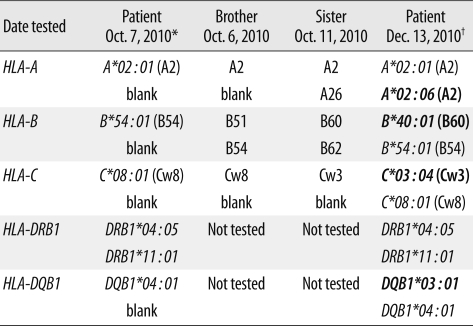1. Garrido F, Cabrera T, Concha A, Glew S, Ruiz-Cabello F, Stern PL. Natural history of HLA expression during tumour development. Immunol Today. 1993; 14:491–499. PMID:
8274189.

2. Ferrone S, Marincola FM. Loss of HLA class I antigens by melanoma cells" molecular mechanisms, functional significance and clinical relevance. Immunol Today. 1995; 16:487–494. PMID:
7576053.
3. Garrido F, Ruiz-Cabello F, Cabrera T, Pérez-Villar JJ, López-Botet M, Duggan-Keen M, et al. Implications for immunosurveillance of altered HLA class I phenotypes in human tumours. Immunol Today. 1997; 18:89–95. PMID:
9057360.

4. Browning M, Petronzelli F, Bicknell D, Krausa P, Rowan A, Tonks S, et al. Mechanisms of loss of HLA class I expression on colorectal tumor cells. Tissue Antigens. 1996; 47:364–371. PMID:
8795136.

5. D'Urso CM, Wang ZG, Cao Y, Tatake R, Zeff RA, Ferrone S. Lack of HLA class I antigen expression by cultured melanoma cells FO-1 due to a defect in B2m gene expression. J Clin Invest. 1991; 87:284–292. PMID:
1898655.
6. Spies T, DeMars R. Restored expression of major histocompatibility class I molecules by gene transfer of a putative peptide transporter. Nature. 1991; 351:323–324. PMID:
2034277.

7. Browning MJ, Krausa P, Rowan A, Hill AB, Bicknell DC, Bodmer JG, et al. Loss of human leukocyte antigen expression on colorectal tumor cell lines: implications for anti-tumor immunity and immunotherapy. J Immunother Emphasis Tumor Immunol. 1993; 14:163–168. PMID:
8297898.
8. Koopman LA, Mulder A, Corver WE, Anholts JD, Giphart MJ, Claas FH, et al. HLA class I phenotype and genotype alterations in cervical carcinomas and derivative cell lines. Tissue Antigens. 1998; 51:623–636. PMID:
9694355.

9. Torres MJ, Ruiz-Cabello F, Skoudy A, Berrozpe G, Jimenez P, Serrano A, et al. Loss of an HLA haplotype in pancreas cancer tissue and its corresponding tumor derived cell line. Tissue Antigens. 1996; 47:372–381. PMID:
8795137.

10. Soong TW, Hui KM. Locus-specific transcriptional control of HLA genes. J Immunol. 1992; 149:2008–2020. PMID:
1517566.
11. Koopman LA, van Der Slik AR, Giphart MJ, Fleuren GJ. Human leukocyte antigen class I gene mutations in cervical cancer. J Natl Cancer Inst. 1999; 91:1669–1677. PMID:
10511595.

12. Jiménez P, Cantón J, Collado A, Cabrera T, Serrano A, Real LM, et al. Chromosome loss is the most frequent mechanism contributing to HLA haplotype loss in human tumors. Int J Cancer. 1999; 83:91–97. PMID:
10449614.
13. McEvoy CR, Morley AA, Firgaira FA. Evidence for whole chromosome 6 loss and duplication of the remaining chromosome in acute lymphoblastic leukemia. Genes Chromosomes Cancer. 2003; 37:321–325. PMID:
12759931.

14. Coppage M, Busacco A, Lenog N, Rothberg P, Phillips G, Becker M. Leukemia specific loss of heterozygosity at MHC locus detected at confirmatory typing of HSCT recipient with CLL. Hum Immunol. 2010; 71(S):S130.
15. Maleno I, López-Nevot MA, Cabrera T, Salinero J, Garrido F. Multiple mechanisms generate HLA class I altered phenotypes in laryngeal carcinomas: high frequency of HLA haplotype loss associated with loss of heterozygosity in chromosome region 6p21. Cancer Immunol Immunother. 2002; 51:389–396. PMID:
12192539.

16. Masuda K, Hiraki A, Fujii N, Watanabe T, Tanaka M, Matsue K, et al. Loss or down-regulation of HLA class I expression at the allelic level in freshly isolated leukemic blasts. Cancer Sci. 2007; 98:102–108. PMID:
17083564.

17. Baccichet A, Qualman SK, Sinnett D. Allelic loss in childhood acute lymphoblastic leukemia. Leuk Res. 1997; 21:817–823. PMID:
9393596.

18. Takeuchi S, Bartram CR, Wada M, Reiter A, Hatta Y, Seriu T, et al. Allelotype analysis of childhood acute lymphoblastic leukemia. Cancer Res. 1995; 55:5377–5382. PMID:
7585604.
19. Ljungman P, de Witte T, Verdonck L, Gahrton G, Freycon F, Gravett P, et al. Bone marrow transplantation for acute myeloblastic leukaemia: an EBMT Leukaemia Working Party prospective analysis from HLA-typing. Br J Haematol. 1993; 84:61–66. PMID:
8338779.

21. Treleaven JG, Barrett AJ, editors. Hematopoietic stem cell transplantation in clinical practice. 2008. 1st ed. Churchill Livingstone;p. 224.







 PDF
PDF ePub
ePub Citation
Citation Print
Print



 XML Download
XML Download